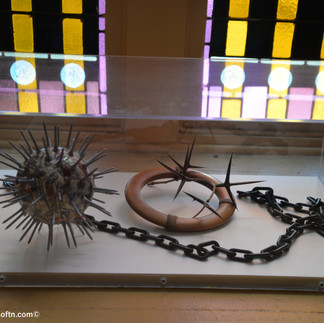Egyptian Marvel: Downtown Presbyterian Church, Nashville
- lvenegas13
- Aug 11, 2023
- 6 min read
Updated: Nov 21, 2024
154 Rep. John Lewis Way, Nashville, TN 37219
615-254-7584
Tours every 4th Friday of the month from 12pm-2pm.

WARNING: You’ve never seen another church like this one, nor are you likely to ever again. This is more than a church. This is Eye Candy. Coffee table book material. A gorgeous work of art that shouts and swaggers! How can one church be so stunning? So dignified yet brazen in its glory? If you have dreams of going to an Egyptian temple, or recall one from a past life, this is a Sacred Site you must see!

Don’t just take my word for its beauty! Downtown Presbyterian Church has garnered a great deal of national attention for its design. According to Wikipedia it is one of the only surviving examples of Egyptian Revival Architecture in the United States and is considered the finest of the three remaining ecclesiastical examples. (The other two are First Presbyterian Church, A.K.A. Old Whalers Church, Sag Harbor, New York, and First Baptist Church of Essex, Connecticut. But I doubt they come close!) It has been designated a National Historic Landmark and is listed in the U.S. National Register of Historic Places. So, this place is rare, spectacular, and very, very special.
Let’s dive into the incredible design of the church, because there is so much to see here!
When Napoleon’s campaign of 1798-1799 to Egypt brought back exotic images of what they found, a fever for Egyptian artifacts and design swept through the world. People simply could not get enough of the astonishing colors, ornamentation, and details, and soon architects and artisans were busy drafting to replicate these motifs in buildings, furniture, jewelry, and even churches. Churches?! Churches and temples worship different Gods, do they not? How do you reconcile the monumental artistry of ancient Egypt and its polytheistic beliefs with the solid countenance of Christianity and monotheism? Margaret M. Grubiak in her study of Egyptian Revival architecture believes that Americans chose to change the meanings of Egyptian forms for their own purposes, substituting Christian for pagan connotations to define a new spiritual world. (Here are some books on the subject.*) But doing this on a large scale is no easy task, and only a few architects and congregations attempted Egyptian Revival when it came to building churches. So how did this church come to be created in Nashville, and by who?
An article by Donna Dorian Wall in Southeast Folio magazine in 1998 had some great information about the church that I’ll share here along with Wiki: Downtown Presbyterian Church was built in 1816 but suffered from devastating fires in 1832 and again in 1848. Luckily, the famed architect William Strickland had come to Nashville from Philadelphia in 1845 to design the Tennessee state capitol which he created in the Greek Revival style. Steeped in classic design, Strickland was considered the most important architect to have lived in Nashville, the Athens of the South, and he was asked to submit a plan to replace the First Presbyterian Church. Fascinated by the Egyptian illustrations being published by scholars and artists, Strickland created the blueprint for the church, which was surely controversial for its time (and may be now). There must have been great discussion among the parishioners as to mixing the beliefs of the Presbyterians with replicas of the great Temple of Karnak; of combining the winged sun disk of Ra and stained-glass windows of palm trees with Christian themes of crosses and organs. Luckily, the vision of those willing to take a design risk won out, and Strickland’s design was completed by 1851.

Unfortunately, a shortage of funds meant that while the interior elements were fantastic, the colors were not (it was mostly grey). It wasn’t until the 1880’s that two decorative painters were able to be hired to bring the church to life. Theo Knoch and John Schliecher were German artists who had recently completed the fresco paintings at the capitol, and they must have been very excited by the project in front of them. Soon the symbols, patterns and colors seen in Egypt were lovingly crafted, including stunning floor-to-ceiling trump l’oeil paintings, stenciled walls, and canvas ceiling panels that recreated the Egyptian sky. Some of the symbols you are likely to see are the Winged Sun: a symbol of divinity, power and protection; lotus flowers: symbolizing rebirth and purity; and columns resembling the Djed forms: representing stability and linked to Osiris, God of the Underworld. Just to enter through the doors is to feel wonder and excitement. Is this how people felt walking into an Egyptian temple, seeking contact with the Gods? Were the colors and designs just as important as words and stories to bring you ever closer to Spirit?
Another standout feature of the Sanctuary is the enormous pipe organ. According to the church website the original organ purchased in 1858 was removed by the Union Army during its occupation of the church, and a second organ was purchased in 1874. This was enlarged in 1913 and again in 1972 by Austin Organ Co. and Milner Organ Co., respectively, and the grand total of pipes is now an astonishing 2,709! I was invited to access a secret door to crawl beneath the organ to see the bellows and wooden pipes; it was amazing! (I barely made it through the door. Only small people need apply for this job!)
A chapel located behind the Sanctuary is also a must-see. The beautiful blue and white room is so sunny and inviting and seems like a private, inner sanctum; another reason to visit this gorgeous church if you get the chance!
Downtown Presbyterian Church also plays an important role in Nashville history from some of its earliest days as a city. It was one of the first churches built in the city in 1814, and was originally named First Presbyterian Church when services began, but was renamed in 1955 when First Presbyterian moved out to the suburbs and the remaining congregation chose to stay put. The church was the site of services for two men who would become President of the US: one for General Andrew Jackson when he was presented a ceremonial sword after the successful Battle of New Orleans; and in 1832 for the inauguration of James K. Polk as Governor of Tennessee. During the Civil War it became a military hospital for Union forces, was used by soldiers in WWII, and temporarily housed victims of a downtown flood in 1927 and 1937 (and probably the one of 2010). Mrs. James K. Polk, before she became First Lady of the Nation and was First Lady of Tennessee, secured her favorite seat in a pew directly behind Adelicia Acklen, who was one of the wealthiest women in the U.S. in the 1800's. (You can see my pictures of Acklen's stunning crypt at Mt. Olivet Cemetery in this post.) The room between the Sanctuary and the Chapel has pictures and items from the church's history that are pretty interesting to see, including a bible that survived the fire of 1832 that destroyed the church, and another beautiful stained-glass window.
The upstairs balcony has a fabulous view of the Sanctuary below, and its seating are chairs from an old Opera house that include wire fixtures under the seats for top hats! From here you have a superb view of the ceiling tiles that are meant to convey the skies in Egypt, and a close-up view of more stencils and stained-glass windows. Interesting notes: The stairs leading to the balcony are covered in leather, and the rope to ring the church bell is located here.
You can find a number of art installations at the church, such as a statue of Jesus by Allan LeQuire, who also created Athena for The Parthenon in Nashville's Centennial Park. Artists-In-Residence are regularly invited to exhibit.
The church holds annual organ recitals (which must be amazing to hear!) and has an active participation in helping the homeless by serving hot meals every Wednesday for lunch and Sunday for breakfast. It provides an office for The Contributor, and helps other non-profits such as Open Table, Matthew 25, Monroe Harding Children’s Home, Siloam Clinic and Room In The Inn. Please consider a donation to support the upkeep of this important and historic building when you visit.
Downtown Presbyterian Church is on the corner of Rep. John Lewis Way and Church Street and offers a tour of the church every fourth Friday of the month from 12pm-2pm. At the church you can grab a flyer with a QR code that provides a video by the church historian Jim Hoobler, who discusses the history of the church and describes the space within. I had a great tour guide who is a church member and was very knowledgeable and enthusiastic about his beautiful church, and it made the visit even more enjoyable. If you go, please let me know what you think about your experience!
*As an Amazon Associate I earn from qualifying purchases. If you are interested in Egyptian symbols and Egyptian Revival Architecture, please consider purchasing books using my link so that I can keep this blog going!













































































Comments